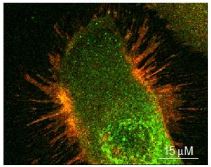Signaling in time and space matter
Towards personalized medicine with “old” second messengers
Investigators involved: Martina Schmidt, Nushunge Musheshe, Haoxiao Zuo, Bing Han
The human genome encodes as the largest family of receptor proteins the G protein-coupled receptors (GPCRs) which represent the largest group of drug targets. The concept of agonist bias at GPCR's has transformed our understanding of cellular regulation by providing the 'old' second messenger concept, and, importantly, the conceptual roots of compartmentalised signaling. Key players in compartmentalised GPCR signaling networks are cyclic nucleotide cyclases, that synthesise cAMP and cGMP, phosphodiesterases that hydrolyse cyclic nucleotides, and scaffolding proteins of the A-kinase anchoring protein family next to protein kinase A (PKA) and the exchange protein directly activated by cAMP (Epac) . Adaptation of GPCR signaling bias likely address several preclinical challenges of modern drug discovery. Spatiotemporal dynamics in the subcellular distribution of GPCR signaling networks likely determine the net outcome of several detrimental processes, including chronic inflammation or altered metabolism. Such networks funnel into mitochondria, the key organelles of energy metabolism. Preservation of mitochondrial function is essential in maintaining cell survival and increase longevity, and most important, keep key players of GPCR signaling in the right place in the right time. The concepts of signal bias, signal compartments and mitochondrial stress will be merged on the level of GPCRs.

Special focus will be on the novel molecular mechanisms preserving cellular GPCR compartments and mitochondrial functions to alleviate symptoms of chronic inflammation as origin of diseases diverse as heart failure, pulmonary hypertension, asthma, COPD, (cystic) fibrosis, Parkinson and Alzheimer’s dementia. We focus on m ammalian cell, tissue cultures and animal models as necessary tools for gaining an understanding of the molecular pharmacology of a drug. Though in vitro drug screening is well established, it is often difficult to accurately extrapolate test results back to possible therapeutic or pathological effects in the human being. As a result, a large majority of drug candidates fail in clinical trials. Using microfluidics, we intend to create nL-environments that better mimic the in vivo situation.
Relevant literature:
Schmidt, M. , Dekker, F. & Maarsingh, H. (2013) Exchange protein directly activated by cAMP (Epac): a multidomain cAMP mediator in the regulation of diverse biological functions. Pharmacol. Rev. 65, 670-709
Han B, Poppinga WJ, Zuo H, Zuidhof AB, Bos IS, Smit M, Vogelaar P, Krenning G, Henning RH, Maarsingh H, Halayko AJ, van Vliet B, Stienstra S, Graaf AC, Meurs H, Schmidt M. The novel compound Sul-121 inhibits airway inflammation and hyperresponsiveness in experimental models of chronic obstructive pulmonary disease. Sci Rep . 2016 May 27;6:26928. doi: 10.1038/srep26928.
Jansen SR, Poppinga WJ, de Jager W, Lezoualc'h F, Cheng X, Wieland T, Yarwood SJ, Gosens R, Schmidt M. (2016) Epac1 links prostaglandin E2 to β-catenin-dependent transcription during epithelial-to-mesenchymal transition. Oncotarget. 2016 Jun 17. doi: 10.18632/oncotarget.10128.
| Last modified: | 03 October 2017 12.46 p.m. |
